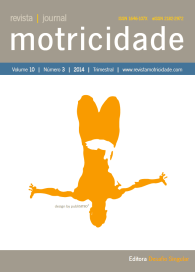Muscle activation differences between stable push-ups and push-ups with a unilateral v-shaped suspension system at different heights
DOI:
https://doi.org/10.6063/motricidade.3395Abstract
This study was designed to analyze upper extremity and core muscle activation performing push-ups under different stability conditions and body positions. Trained university male students (n= 29) performed 3 push-ups each under stable conditions and using suspension device (AirFit Trainer ProTM) with their hands at 2 different heights (i.e., 10 and 65 cm). Push-up speed was controlled using a metronome and the testing order was randomized. The average amplitudes of the electromyographic root mean square of the Triceps Brachii, Upper Trapezius, Anterior Deltoid, Clavicular Pectoralis, Rectus Abdominis, Rectus Femoris, Lumbar Erector Spinae and Gluteus Maximus were recorded and normalized to the maximum voluntary isometric contraction. A repeated-measures analysis of variance with a Bonferroni post hoc test was used to analyze data. Suspended push-ups provided greater activity than the stable condition, except for the Anterior Deltoid and Clavicular Pectoralis. Therefore, suspended push-ups are especially advantageous if the goal of the exercise is targeting the TRICEP, TRAPS and/or core training. Overall, performing push-ups at 65 cm from the floor decreases exercise intensity and muscle activity in comparison with the 10 cm position.
Downloads
Published
Issue
Section
License
The authors of submitted manuscripts must transfer the full copyright to Journal Motricidade / Sílabas Didáticas Editions. Granting copyright permission allows the publication and dissemination of the article in printed or electronic formats, and copyrights start at the moment the manuscript is accepted for publication. It also allows Journal Motricidade to use and commercialise the article in terms of licensing, lending or selling its content to indexation/abstracts databases and other entities.
According to the terms of the Creative Commons licence, authors may reproduce a reasonable number of copies for personal or professional purposes, but without any economic gain. SHERPA/RoMEO allows authors to post a final digital copy (post-printing version) of the article on their websites or on their institutions' scientific repository.


